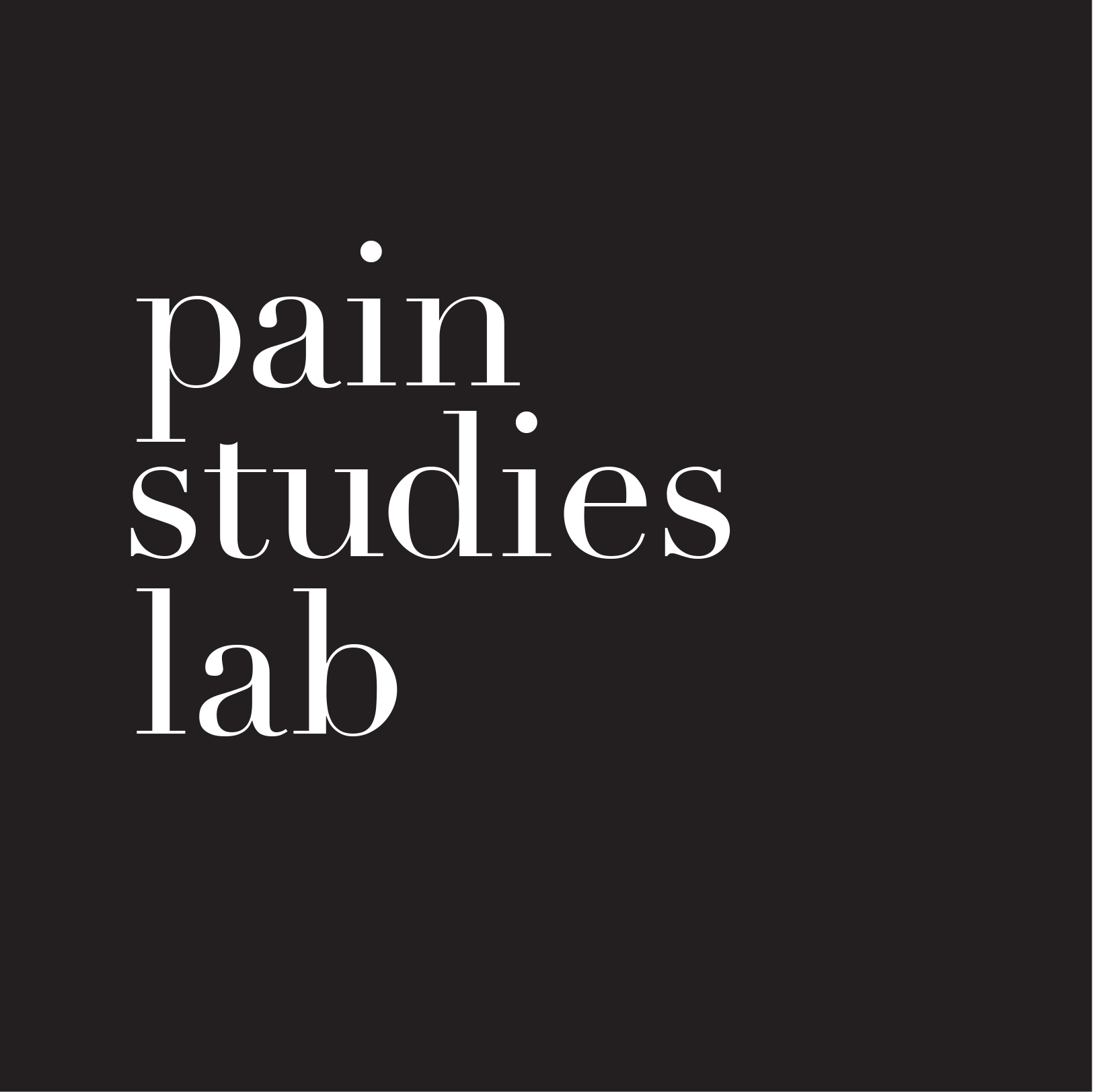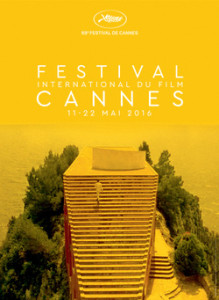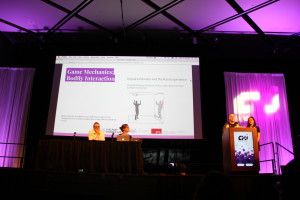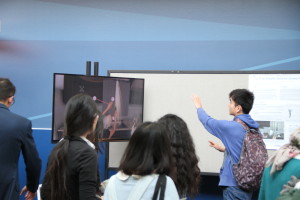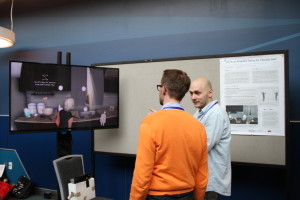The Cannes Film Festival has a category called “Cannes’ Health Lions.” Howard Rose — our industry partner with Ari Hollander at DeepStreamVR — presented our Virtual Meditative Walk as part of his talk Your Brain on VR: Virtual Worlds, Real Results” at noon on Sunday 19 June on the Health in Action Stage.
Mark Nazemi, Ph.D. candidate and researcher at the Pain Studies Lab presented at “Design Research in Health Care conference in Lucerne, Switzerland in January, 2016. Nazemi’s research is titled “Immersive Sound Techniques + VR for Pain Anxiety Management.” This research provides an alternative non-invasive approach using customized 3-D immersive audio recordings to manage pain and anxiety. This highly specific listening process creates a perceptual change of environment providing relief for the listener. His research also discusses how VR therapy is used for pain management and mindfulness training.
Mark Nazemi, “Immersive Sound Techniques + VR for Pain Management”, D-Health Conference. 2016. University of Lucerne, Switzerland.
Pain Studies Lab researcher and BC registered social worker, Dimple Gupta, has been a member of the Pain BC Education Committee since Fall, 2014. The purpose and goal of this committee is to assist Pain BC to design and review continuing education programs to train inter-disciplinary health care professionals. The education programs and trainings are focused on bringing knowledge and skills to health care professionals on various chronic pain topics. The Pain BC Education Committee meets regularly under the chairpersonship of Frances Kirson, Education Engagement Director, Pain BC. Visit the Pain BC website to learn more about trainings offered: https://www.painbc.ca/health-care-providers
AS IF competes at CHI 2016 Student Game Competition as one of the Finalists Team
Pain Lab Ph.D. students Xin Tong, Servet Ulas and Weina Jin demonstrated their empathy game AS IF in CHI 2016 Student Game Competition. As one of the finalists they earned a Certificate of Recognition and AS IF also drew a lot of attention from attendees at CHI during the 3-day game demo as well as the final presentation. The game, incorporated with patients embodied experience, puts players in the shoes of people with Chronic Pain to give them insight and have them experience what it may be like living even a single day with this long-lasting affliction.
The ACM Conference on Human Factors in Computing Systems (CHI) series of academic conferences is considered to be the most prestigious in the field of human–computer interaction (HCI) and is one of the top ranked conferences in computer science. The Student Game Competition is a juried track at CHI. Each game was reviewed by both academic and professional experts in game design and development, with emphasis on expertise in the entry categories. The student competitions at CHI continue to grow each year with increased international representation. The competition always draws a large audience at CHI and has also become a major recruiting opportunity for identifying talented students.
Related Publication:
Jin, W., Ulas, S., and Tong, X. AS IF: A Game As an Empathy Tool for Experiencing the Activity Limitations of Chronic Pain Patients. Proceedings of the 2016 CHI Conference Extended Abstracts on Human Factors in Computing Systems, ACM (2016), 172–175.
Pain Studies Lab members presented results of their research at the Medicine Meets Virtual Reality (MMVR) 2016 conference in Los Angeles, April 7-9. MMVR is an international scientific forum on advanced computer-based technologies for medical care and education. Its participants are scientists, engineers, physicians, educators, students, military and industry members, and healthcare futurists.
Dr. Chris Shaw presented a talk entitled Usability Comparisons of Head-Mounted vs. Stereoscopic Desktop Displays in a Virtual Reality Environment with Pain Patients,” an investigation of simulator sickness in VR displays when used specifically by pain patients. Weina Jin introduced the results of a clinical study involving VR as a method of pain distraction. The study examined the efficacy of a VR “game designed at the Pain Lab specifically for people who live with long-term chronic pain. An example of a serious game,” the study demonstrated that it is an effective method of pain distraction.
This and other studies were limited to measuring the short-term analgesic effects of VR, but according to Dr. Gromala, who heads the Pain Studies Lab, chronic pain patients have multiple needs for pain relief,” in the short-term, during times of breakthrough pain, and over long periods of time. She adds, “while we developed a new paradigm for VR that we hope may prove useful for the long-term, we are committed to discovering the ways that VR — or any technology — can help.
Ashfaq Amin presented Immersion in Cardboard VR Compared to a Traditional Head-Mounted Display.” This poster describes a study conducted among 30 participants who used 3 different VR displays — Cardboard VR, Oculus Rift DK2, and Desktop. Participants in the study played the same VR game, and their experience of immersion was recorded using an Immersive Experience Questionnaire. Surprisingly, the results showed that Cardboard VR, despite its low resolution, performs almost as well as the Oculus Rift head-mounted display (HMD). Ashfaq, who is exploring affordable mobile VR technologies for pain self-management, carried home a best poster award for his work.
The findings of these studies were presented by individual researchers, but are the result of a team of interdisciplinary researchers in SFU’s Pain Studies Lab. The research was made possible by support from the Canadian Foundation for Innovation (CFI), the Canada Research Chair Program, NSERC (Natural Sciences and Engineering Research Council of Canada), NCE-GRAND, and Simon Fraser University; pain experts Dr. Pamela Squire, Dr. Owen Williamson and Dr. Brenda Lau; and patients/members of British Columbia’s non-profit organization PainBC.

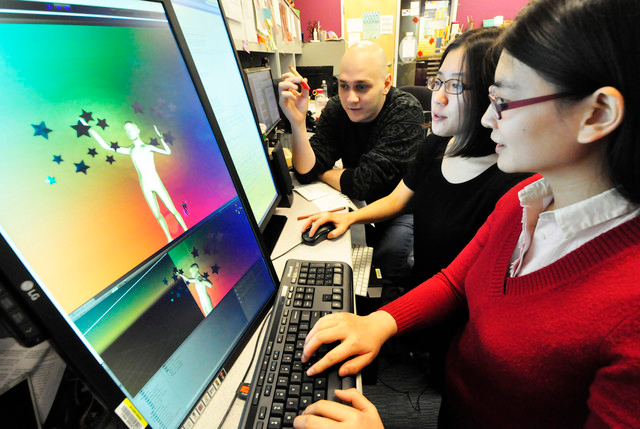
AS IF, a project realized by our graduate students, Weina Jin, Servet Ulas and Xin Tong has been chosen to compete at the CHI Student Game Competition. AS IF aims to foster empathy towards patients who suffer from Chronic Pain by putting the user in the shoes of a patient and simulating the physical hindrances Chronic Pain causes. The participant is asked to complete simple motor tasks which involve touching shapes in a given order to reveal a shape. The tasks and the interactions are tied together with a narrative from the Chronic Pain patients perspective. Our team will be demoing and presenting AS IF at CHI in May 2016, see you there!
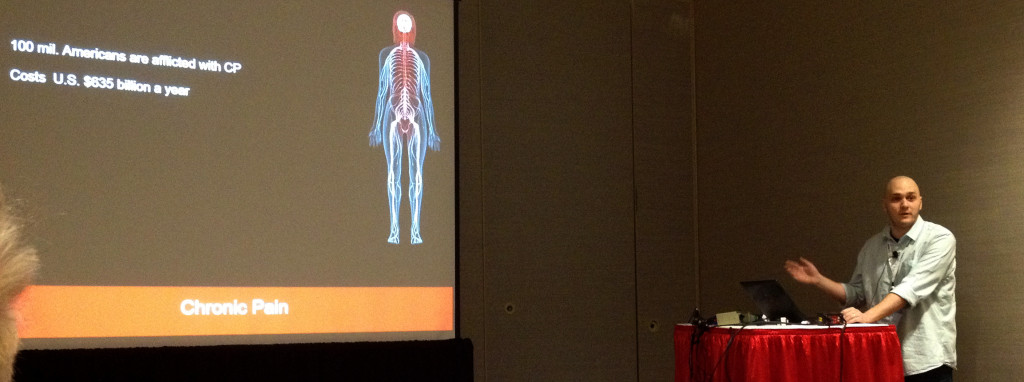
Dr. Gromala, Dr. Shaw and our new member PhD. candidate Servet Ulas was at SPIE 2016, presenting. The paper presented in the panel chaired by Ian McDowall was Mobius Floe: an Immersive Virtual Reality Game for Pain Distraction. After a brief overview of our work and what Chronic Pain is and how Pain Distraction works explained by the attention capacity theory, Servet explained the game mechanics and the design decisions involved in the creation of Mobius Floe, how the metaphors employed in the conception of the gameworld may help with the explanation of a complex affliction that can only be managed with a biopsychosocial approach.
As part of the tradition of earning a PhD, Tyler Fox was “hooded” by his senior supervisor Dr. Gromala at SFU’s Fall Convocation ceremonies in October. PhDs earn the degree and additions to the graduation gear, namely, a long silken hood and a Renaissance-looking cap. Dr. Fox is now on faculty and is the Studio Director for the Interactive Media Design program at the University of Washington.
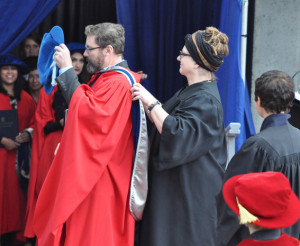
Xins new paper is about how ideas of Body Image and Body Schema (BIBS) literature may enlarge general Virtual Reality (VR) research and how this motivates our design of VR for chronic pain patients. (space) The researchers focused on their new VR project designed for girls who undergo surgery for Scoliosis, and discussed how BIBS is used in this research more concrete ways. This project is lead by Dr. Diane Gromala and collaborator Dr. Gillian Lauder from BC Childrens and Womens Hospital in Vancouver, Canada. Her new work was built on former graduate student Ozgun Eyluls BIBS research. Tong plans to present this work as an oral presentation on 9 February 2015 at the SPIE conference. SPIE is an international society advancing an interdisciplinary approach to the science and application of light.

Xin Tong successfully defended her M.Sc. thesis defence under supervisor Dr. Diane Gromala at the School of Interactive Arts and Technology, Simon Fraser University in August 2015.Tong’s thesis is titled Encouraging Physical Activity with Gamification Approaches: Goal-setting, Social Community, and “FitPet” Game-based Mobile Application. It focuses on investigating the effectiveness of certain gamification approaches for encouraging physical activity. Tong also developed the mobile interactive game — FitPet. The game associates the players physical activity (steps) to his/her virtual pets health condition and the growth level. She then compared it with two other common gamification strategies in a six-week field study. Results revealed that social interaction was the most effective one under certain condition among all three approaches. Although participants physical activity level in FitPetgroup did not have significant difference compared to the control group, participants liked the game and they gave suggestions to make the game more engaging. In her thesis, Tong also offers design implications for developing future gamification strategies for promoting physical activity, which are summarized from her interviews with the participants. Later, Pain Studies Lab researchers got together to celebrate Tong’s thesis completion.

Left to right:
Ashfaq Amin, Weina Jin, Dimple Gupta, Abhishek Gupta, Mahsoo Salimi
Mine, Servet Ulas, Xin Tong, Dr. Diane Gromala, Dr. Chris Shaw, Gillian Ramsay
